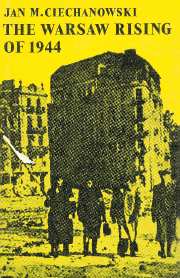Book contents
- Frontmatter
- Contents
- Abbreviations
- Acknowledgements
- Introduction
- Map
- 1 The Big Three and Poland: July 1943–July 1944
- 2 The Genesis of the Polish Resistance Movement
- 3 Attempts to Unify the Polish Resistance Movement
- 4 The Polish Grand Strategy, 1941–1943
- 5 The ‘Tempest’ Plan
- 6 The London Poles and ‘Tempest’
- 7 The ‘Tempest’ East of Warsaw
- 8 The Fate of Warsaw
- 9 Why Warsaw Rose
- 10 Warsaw and the Émigré Leaders
- Conclusions
- Bibliography
- Index
8 - The Fate of Warsaw
Published online by Cambridge University Press: 04 August 2010
- Frontmatter
- Contents
- Abbreviations
- Acknowledgements
- Introduction
- Map
- 1 The Big Three and Poland: July 1943–July 1944
- 2 The Genesis of the Polish Resistance Movement
- 3 Attempts to Unify the Polish Resistance Movement
- 4 The Polish Grand Strategy, 1941–1943
- 5 The ‘Tempest’ Plan
- 6 The London Poles and ‘Tempest’
- 7 The ‘Tempest’ East of Warsaw
- 8 The Fate of Warsaw
- 9 Why Warsaw Rose
- 10 Warsaw and the Émigré Leaders
- Conclusions
- Bibliography
- Index
Summary
The Preliminary Decision
The decision to begin hostilities against the Germans in the capital of Poland was taken in Warsaw in the second half of July 1944. The preliminary decision was made between 21 July and 25 July, while the final order to begin Home Army operations in Warsaw was issued early in the evening of 31 July 1944.
Before 21 July, a battle for the city had been contemplated only as part of a ‘universal and simultaneous rising’. The capture of Warsaw, at the moment of German collapse on the Eastern Front, was to be an essential feature of this operation. This is supported by ample evidence. In March 1944 Gen Bor-Komorowski decided to specifically exclude the capital from the ‘Burza’ operations to save the city from destruction and spare its population unnecessary suffering. The Home Army troops in Warsaw were charged only with the duty of protecting the population from possible German excesses and forced evacuation during the German retreat from the city. In accordance with this plan, it was envisaged that a well-armed Home Army unit, about 4,000 strong, would leave Warsaw to fight against the Germans outside the city.
What is more significant, from March 1944 weapons received from British sources, or made clandestinely, were not stored for future use in Warsaw, being directed instead to the Home Army's eastern regions, which were the first to shoulder the main burden of ‘Burza’. Hence, as late as 7 July 1944, on the direct orders of Bor-Komorowski 900 sub-machine guns and appropriate ammunition were sent from Warsaw's arms caches to eastern Poland.
- Type
- Chapter
- Information
- The Warsaw Rising of 1944 , pp. 212 - 242Publisher: Cambridge University PressPrint publication year: 1974



